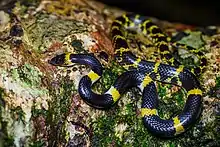| Lycodon laoensis | |
|---|---|
 | |
| specimen at Khao Chamao Waterfall, Khao Chamao–Khao Wong National Park | |
| Scientific classification | |
| Domain: | Eukaryota |
| Kingdom: | Animalia |
| Phylum: | Chordata |
| Class: | Reptilia |
| Order: | Squamata |
| Suborder: | Serpentes |
| Family: | Colubridae |
| Genus: | Lycodon |
| Species: | L. laoensis |
| Binomial name | |
| Lycodon laoensis Günther, 1864 | |
| Synonyms | |
|
Ophites laoensis - Zhao & Adler, 1993[2] | |
Lycodon laoensis, commonly known as the Laotian wolf snake, is a species of non-venomous colubrid snake endemic to Asia.
Geographic range

It is found in India, Thailand, Laos, Vietnam, Cambodia, China (Yunnan), and West Malaysia. It also has been reported in, Northern Pakistan, areas specially in Haripur District
Description
Dorsally it is dark brown, with a whitish or yellowish crossband on the occiput, and similar body crossbands which bifurcate on the sides. Ventrally it is whitish. Adults are about .5 m (20 inches) in total length, which includes the tail of about 10 cm (4 inches).[3]
They are nocturnal , and generally ground dwelling. They are not very aggressive and generally reluctant to bite.[4]
Like other Wolf Snakes, they can be mistaken for the venomous Banded Kraits.[4]
References
- ↑ Chan-Ard, T.; Thy, N.; Nguyen, T.Q.; Grismer, L. (2012). "Lycodon laoensis". IUCN Red List of Threatened Species. 2012: e.T192203A2055050. doi:10.2305/IUCN.UK.2012-1.RLTS.T192203A2055050.en. Retrieved 19 November 2021.
- ↑ Lycodon laoensis, The Reptile Database. www.reptile-database.com
- ↑ Boulenger, G.A. 1893. Catalogue of the Snakes in the British Museum (Natural History), Volume I. Trustees of the British Museum (Natural History). London. p. 354 & Plate XXIV. fig. 2.
- 1 2 "Common snakes of Thailand". Siam-Info. Retrieved July 8, 2018.
External links
Further reading
- Günther, A. (1864). The Reptiles of British India. (Taylor & Francis, printers). London. xxvii + 452 pp.
- Lanza, B. (1999). A new species of Lycodon from the Philippines, with a key to the genus (Reptilia: Serpentes: Colubridae). Tropical Zoology 12:89-104.
